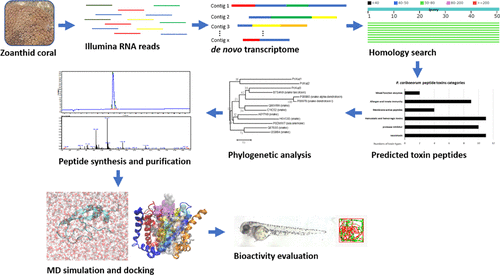当前位置:
X-MOL 学术
›
J. Proteome Res.
›
论文详情
Our official English website, www.x-mol.net, welcomes your
feedback! (Note: you will need to create a separate account there.)
Novel Kunitz-like Peptides Discovered in the Zoanthid Palythoa caribaeorum through Transcriptome Sequencing
Journal of Proteome Research ( IF 3.8 ) Pub Date : 2018-01-12 00:00:00 , DOI: 10.1021/acs.jproteome.7b00686 Qiwen Liao , Shengnan Li , Shirley Weng In Siu , Binrui Yang , Chen Huang , Judy Yuet-Wa Chan , Jean-Étienne R. L. Morlighem 1 , Clarence Tsun Ting Wong 2 , Gandhi Rádis-Baptista 1 , Simon Ming-Yuen Lee
Journal of Proteome Research ( IF 3.8 ) Pub Date : 2018-01-12 00:00:00 , DOI: 10.1021/acs.jproteome.7b00686 Qiwen Liao , Shengnan Li , Shirley Weng In Siu , Binrui Yang , Chen Huang , Judy Yuet-Wa Chan , Jean-Étienne R. L. Morlighem 1 , Clarence Tsun Ting Wong 2 , Gandhi Rádis-Baptista 1 , Simon Ming-Yuen Lee
Affiliation

|
Palythoa caribaeorum (class Anthozoa) is a zoanthid that together jellyfishes, hydra, and sea anemones, which are venomous and predatory, belongs to the Phyllum Cnidaria. The distinguished feature in these marine animals is the cnidocytes in the body tissues, responsible for toxin production and injection that are used majorly for prey capture and defense. With exception for other anthozoans, the toxin cocktails of zoanthids have been scarcely studied and are poorly known. Here, on the basis of the analysis of P. caribaeorum transcriptome, numerous predicted venom-featured polypeptides were identified including allergens, neurotoxins, membrane-active, and Kunitz-like peptides (PcKuz). The three predicted PcKuz isotoxins (1–3) were selected for functional studies. Through computational processing comprising structural phylogenetic analysis, molecular docking, and dynamics simulation, PcKuz3 was shown to be a potential voltage gated potassium-channel inhibitor. PcKuz3 fitted well as new functional Kunitz-type toxins with strong antilocomotor activity as in vivo assessed in zebrafish larvae, with weak inhibitory effect toward proteases, as evaluated in vitro. Notably, PcKuz3 can suppress, at low concentration, the 6-OHDA-induced neurotoxicity on the locomotive behavior of zebrafish, which indicated PcKuz3 may have a neuroprotective effect. Taken together, PcKuz3 figures as a novel neurotoxin structure, which differs from known homologous peptides expressed in sea anemone. Moreover, the novel PcKuz3 provides an insightful hint for biodrug development for prospective neurodegenerative disease treatment.
中文翻译:

通过转录组测序在Zoanthid Palythoa caribaeorum中发现的新型Kunitz样肽
Palythoa caribaeorum(类Anthozoa)是一种蠕虫,将有毒和掠食性的水母,水蛇和海葵归为Phyllum Cnidaria。这些海洋动物的显着特征是人体组织中的cnidocytes,负责毒素的产生和注射,主要用于捕食和防御猎物。除其他花青虫外,很少有人对拟寄生虫的毒素混合物进行研究,并且鲜为人知。在此,基于对加勒比假单胞菌的分析转录组中,鉴定了许多预测的具有毒液特征的多肽,包括过敏原,神经毒素,膜活性肽和库尼兹样肽(PcKuz)。选择了三种预测的PcKuz异毒素(1-3)进行功能研究。通过包括结构系统发育分析,分子对接和动力学模拟在内的计算处理,PcKuz3被证明是一种潜在的电压门控钾通道抑制剂。PcKuz3非常适合作为新的功能性Kunitz型毒素,如在斑马鱼幼虫体内评估的那样,具有很强的抗运动能力,对蛋白酶的抑制作用较弱,如体外评估。值得注意的是,PcKuz3可以在低浓度下抑制6-OHDA诱导的对斑马鱼机车行为的神经毒性,这表明PcKuz3可能具有神经保护作用。两者合计,PcKuz3被认为是一种新型的神经毒素结构,它不同于在海葵中表达的已知同源肽。此外,新颖的PcKuz3为前瞻性神经退行性疾病治疗的生物药物开发提供了深刻的提示。
更新日期:2018-01-12
中文翻译:

通过转录组测序在Zoanthid Palythoa caribaeorum中发现的新型Kunitz样肽
Palythoa caribaeorum(类Anthozoa)是一种蠕虫,将有毒和掠食性的水母,水蛇和海葵归为Phyllum Cnidaria。这些海洋动物的显着特征是人体组织中的cnidocytes,负责毒素的产生和注射,主要用于捕食和防御猎物。除其他花青虫外,很少有人对拟寄生虫的毒素混合物进行研究,并且鲜为人知。在此,基于对加勒比假单胞菌的分析转录组中,鉴定了许多预测的具有毒液特征的多肽,包括过敏原,神经毒素,膜活性肽和库尼兹样肽(PcKuz)。选择了三种预测的PcKuz异毒素(1-3)进行功能研究。通过包括结构系统发育分析,分子对接和动力学模拟在内的计算处理,PcKuz3被证明是一种潜在的电压门控钾通道抑制剂。PcKuz3非常适合作为新的功能性Kunitz型毒素,如在斑马鱼幼虫体内评估的那样,具有很强的抗运动能力,对蛋白酶的抑制作用较弱,如体外评估。值得注意的是,PcKuz3可以在低浓度下抑制6-OHDA诱导的对斑马鱼机车行为的神经毒性,这表明PcKuz3可能具有神经保护作用。两者合计,PcKuz3被认为是一种新型的神经毒素结构,它不同于在海葵中表达的已知同源肽。此外,新颖的PcKuz3为前瞻性神经退行性疾病治疗的生物药物开发提供了深刻的提示。











































 京公网安备 11010802027423号
京公网安备 11010802027423号